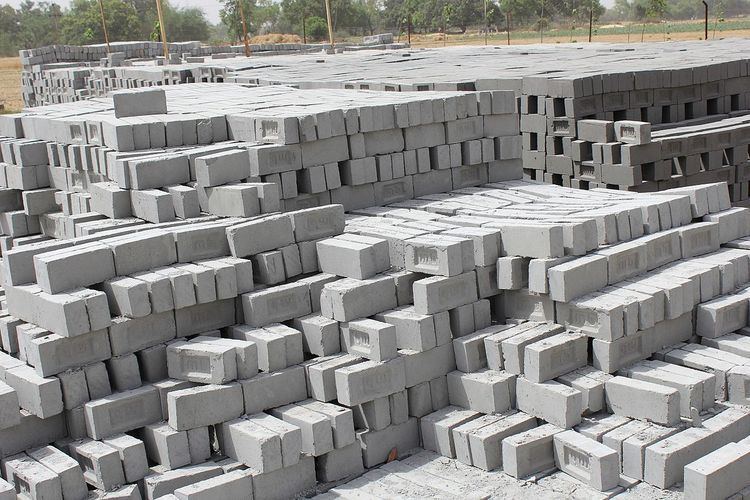 | ||
Fly ash brick (FAB) is a building material, specifically masonry units, containing class C fly ash and water. Compressed at 28 MPa (272 atm) and cured for 24 hours in a 66 °C steam bath, then toughened with an air entrainment agent, the bricks last for more than 100 freeze-thaw cycles. Owing to the high concentration of calcium oxide in class C fly ash, the brick is described as "self-cementing". The manufacturing method saves energy, reduces mercury pollution, and costs 20% less than traditional clay brick manufacturing.
Contents
History
Coal dust has historically been collected as a waste product from homes and industry. During the nineteenth century coal ash was taken by 'scavengers' and delivered to local brick works, where the ash would be mixed with clay. The income from the sale of ash would normally pay for the collection of waste.
The raw materials
The raw materials for Fly Ash Bricks are:
The strength of fly ash brick manufactured with the above compositions is normally of the order of 7.5 N/mm2 to 10 N/mm2. Fly ash bricks are lighter and stronger than clay bricks.
Main ingredients include fly ash, water, quicklime or lime sludge, cement, aluminum powder and gypsum. The block hardness is being achieved by cement strength, and instant curing mechanism by autoclaving. Gypsum acts as a long term strength gainer. The chemical reaction due to the aluminum paste provides AAC its distinct porous structure, lightness, and insulation properties, completely different compared to other lightweight concrete materials. The finished product is a lighter Block - less than 40% the weight of conventional Bricks, while providing the similar strengths. The specific gravity stays around 0.6 to 0.65. This is one single most USP of the AAC blocks, because by using these blocks in structural buildings, the builder saves around 30 to 35 % of structural steel, and concrete, as these blocks reduce the dead load on the building significantly
There are three important ingredients of fly ash which affect the strength and look of fly ash brick.
- Loss on Ignition (LOI); fly ash looses weight when it burns at about 1000°C due to presence of carbon and water. The weight loss happens due to carbon combustion and moisture evaporation is called "Loss on Ignition(LOI)". This is expressed as percentage. The lower the loss of Ignition, the better will be fly ash. As per BIS it should not be more than 5%.
- Fineness; the fine fly ash has more surface area available to react with lime, thus more will be the pozzolanic activity of fly ash. The greater pozzolanic activity contributes to the strength of fly ash brick. As per BIS it should not be more than 320 m2/kg.
- Calcium (CaO) content; the pozzolanic reactivity of fly ash is more in high calcium fly ash. The greater the pozzolanic activity leads to higher the strength of fly ash brick. For C class fly ash CaO should be more than 10% and for F class it might be lower than 10%.
Advantages
- It reduces dead load on structures due to light weight(2.6 kg, dimension: 230 mm X 110 mm X 70 mm).
- Same number of bricks will cover more area than clay bricks
- High fire Insulation
- Due to high strength, practically no breakage during transport and use.
- Due to uniform size of bricks mortar required for joints and plaster reduces almost by 50%.
- Due to lower water penetration seepage of water through bricks is considerably reduced.
- Gypsum plaster can be directly applied on these bricks without a backing coat of lime plaster.
- These bricks do not require soaking in water for 24 hours. Sprinkling of water before use is enough.
Disadvantages
- Mechanical strength is low, but this can be rectified by adding marble waste or mortar between blocks.
- Limitation of size. Only modular size can be produced. Large size will have more breakages.
